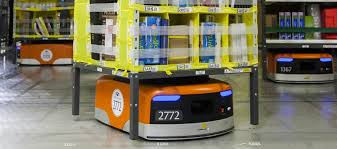Source: which-50.com
Robots are a key component in a digital transformation – rather than an end goal – and most industries should be considering them, according to one of Amazon’s top robotics experts.
The ecommerce giant has been leveraging the technology for years, most commonly to pick goods from within its warehouses, and sees as much benefit in the operational data as the labour savings.
Amazon, which has rolled out over 200,000 robots, also insists the automation technology has not displaced a single worker.
‘Digital Exhaust’
Data from Amazon’s picking robots have led to a redistribution of products in its warehouses, which has lessened the time it takes to fulfil orders.
“Robots are really data generating connected endpoints,” says Roger Barga, Amazon Web Services general manager of robotics and autonomous services.
“They have an internet connection. They’re out there doing a task out in our field. In the case of Amazon robotics, they are moving product around so that it can be easily picked up and put into a box.”
During the AWS re:Invent conference in Las Vegas earlier this month Barga told Which-50 before operationalising its picking robots the company had no idea how much time it took to pick individual products.
“You couldn’t ask a human to write it down, pick it up, [etc]. But because it’s now all automated, we actually have a digital exhaust off of the robot. And we could actually see exactly start time to end time [of picking].”
The new data revealed outlier products which were taking an inexplicably long time to pick. Further analysis revealed there was congestion points in the warehouse when multiple orders and robots were being sent to the same place.
“This gave an insight of ‘Hey, let’s go ahead and randomly distribute products around the fulfilment centre.’ And sure enough, the average pick time went down, the overall throughput went down. And this example has borne itself out over and over again.”
Barga says robots are viable beyond Amazon because almost every organisation stands to benefit from the additional insights robots generate, and they can be modified relatively easily to capture more information, including microphones, cameras, and accelerometers.
He also argues that robots are no longer cost prohibitive, with hardware costs falling and providers, including AWS, offering the technology as a service.
“Over really the last 30 years, the price of robotics and robots has been plummeting. What used to be a $70,000 LIDAR [light imaging, detection, and ranging system] has now dropped down to $1,000.”
Barga says improvements in software also mean less expensive hardware has become more effective. Individual robots units can now be as cheap as $1,000 t0 5,000, according to Barga.
In one case an AWS customer, which Barga can not yet reveal, is using a robot that cost $10,000 to fetch spare parts as needed in an assembly line. He says the project is expected to create savings in the millions.
“This is a trend and it’s no longer cost is an issue. It’s actually why not?”
Barga says CEOs and CIOs looking to implement robots should identify small but costly tasks where humans add no value as a starting point rather than major overhauls.
“Attack that small little piece,” Barga says.
“That’s exactly how I’ve seen successful companies do it. And then they can build up from there but they’ll learn the whole process, they get immediately immediate ROI within six to nine months.”
Robot Future
Asked about concerns that automation will lead to the displacement of jobs, Barga insisted Amazon’s increasing automation is yet to cost a worker their job.
“[Based on] both data [from] what we have today and historical, we’ve absolutely lost no jobs as a result of employing [automation]. We have over 200,000 robots but we’ve never displaced a single worker.”
Barga said robots “automate tasks but they don’t automate jobs” and Amazon needs automation to satisfy “insatiable consumers”.
“They want better experiences, companies want to differentiate to actually get more customers,” he said.
According to Barga, that is how Amazon differentiates – using the same number of employees with added automation to delight customers with efficiency.
“What used to be one week shipping, we’re able to pull down to two days because of automation. We’ve now got that down to one day, and we’re talking with Prime Air and others about getting it down within hours.”


